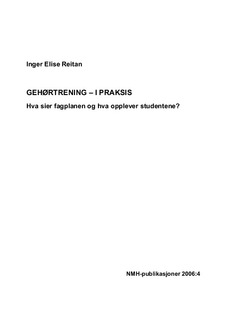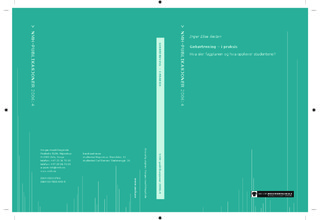| dc.description.abstract | Background, method and material (Chapter 1–3). The aim of this present study is to examine the ear training/aural training discipline in higher music education, solely based on the students’ experience. It is a fact that little research has been done on the subject of ear training. Thus teaching is based more upon experience than on scientific research. This study is based upon a survey carried out in 2001 among students at the Norwegian Academy of Music (NMH). 104 students took part in the survey, which is more than 90% of the total group. In this study I will discuss four main questions:
1. What kind of subject is aural training? (Chapter 4)
2. What is the relation between aural training and the total music study? (Chapter 5)
3. Which abilities, skills and knowledge do we develop in aural training? (Chapter 6)
4. What is the relationship between the aural training teaching and the student him/herself? (Chapter 7)
All the questions have a didactic perspective connected to theory concerning the different levels of a curriculum: from the ideological plan, through the conceived/interpreted, implemented till the experienced plan, which is the aim of this study. As I want to see the relation between the formal written paper and the experienced curriculum, I give an analysis of the actual curriculum for aural training at NMH in which the discipline is one of many subsidiary disciplines. As a background I give a short presentation of relevant theoretical fields connected to the concepts of musicality, the musical ear, perception, knowledge, and learning with special emphasis on the following: developing the relative musical ear, the categorical perception related to Chomsky’s theories of reading for understanding the phenomenon of audiation (the inner ear, perceive and conceive musical structures), a wide concept of knowledge including theory, skills and attitudes, and Dreyfus’ 5 stages in skill learning.
Chapter 4-7: results
Chapter 4 – what kind of subject is aural training? The first spontaneous thoughts or associations about aural training revealed different aspects:
1. The aim and content of the discipline that can be connected to the curriculum.
2. The aspect of achievement, which revealed mostly negative thoughts, like nervousness, bad mastery, not being good at, stress etc.
3. The aspect of motivation, which is mostly positive, expressed in words like: enjoyable, interesting, important, useful, good feelings.
4. The aspect of practice, connected to the instrument, the musical ear in general, and this revealed both a narrow and a wide range of usefulness.
To a question examining whether aural training is a theoretical or a practical discipline, there was a clear tendency towards the practical side (table 4.1). Comments tell that the ‘theory’ is both connected to knowing practical methods and to understanding on a more abstract level. Theory is also connected to conceptions and vocabulary from the theory of music, about scales, harmony, form, style etc.
Chapter 5 – The relationship between aural training, music education and other disciplines
My premise is that even if the study of music is divided into different disciplines, there should be a link between them and that the student should also experience this link.
Chapter 6 – which abilities, skills and knowledge do we develop in aural training?
The main purpose of any discipline in a curriculum is learning. The teacher uses the curriculum as a guide for teaching, but learning is a result of what develops in the student’s mind. The question comprises 28 different abilities, skills and knowledge: to what degree do they learn
or develop these abilities?
Among the 28 different skills and abilities asked for, the ability of harmonic consciousness is recognized as the most important. But the term “most important” might be understood in two different ways: what the student thinks is most important in general or what is most important to develop in aural training.
Chapter 7 – What is the relationship between the aural training teaching and the students themselves?
As the chapters 4-6 were concerned about aural training as a discipline, this chapter is concerned with how the students experience different factors related to themselves, based on seven questions: to what degree they experience the factor of stress, of well-being, of the workload, of the demands of achievement, of one’s own mastery, of one’s own development and the amount of lessons.
There is an inner coherence between the factors. Especially important are the factors of stress and of well-being. The verbal comments to these questions contributed to interpreting the results.
Chapter 8 – Aural training – in practice - conclusion
The connection between the written curriculum and the experienced plan show that the plan is realistic, it is more moderate concerning both the content and what is developed than indicated by the answers from the students, and the teaching in aural training at NMH is very varied. I also discuss what a subsidiary discipline is, and in this context I emphasize the function of audiation as a characteristic of aural training. | en |

